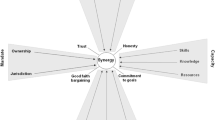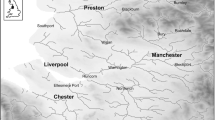Abstract
Experience with collaborative approaches to natural resource and environmental management has grown substantially over the past 20 years, and multi-interest, shared-resources initiatives have become prevalent in the United States and internationally. Although often viewed as “grass-roots” and locally initiated, governmental participants are crucial to the success of collaborative efforts, and important questions remain regarding their appropriate roles, including roles in partnership initiation. In the midst of growing governmental support for collaborative approaches in the mid-1990s, the primary natural resource and environmental management agency in Wisconsin (USA) attempted to generate a statewide system of self-sustaining, collaborative partnerships, organized around the state’s river basin boundaries. The agency expected the partnerships to enhance participation by stakeholders, leverage additional resources, and help move the agency toward more integrated and ecosystem-based resource management initiatives. Most of the basin partnerships did form and function, but ten years after this initiative, the agency has moved away from these partnerships and half have disbanded. Those that remain active have changed, but continue to work closely with agency staff. Those no longer functioning lacked clear focus, were dependent upon agency leadership, or could not overcome issues of scale. This article outlines the context for state support of collaborative initiatives and explores Wisconsin’s experience with basin partnerships by discussing their formation and reviewing governmental roles in partnerships’ emergence and change. Wisconsin’s experience suggests benefits from agency support and agency responsiveness to partnership opportunities, but cautions about expectations for initiating general-purpose partnerships.


Similar content being viewed by others
References
Agee JK, Johnson DR (eds) (1988) Ecosystem management for parks and wilderness. University of Washington Press, Seattle, WA
Alexander ER (1993) Interorganizational coordination: theory and practice. Journal of Planning Literature 7(4):328–343
Allee DJ, Dworsky LB, North RM (1982) Unified river basin management—stage II: symposium proceedings. American Water Resources Association, Minneapolis, MN
Bellamy JA, McDonald GT, Syme GJ, Butterworth JE (1999) Evaluating integrated resource management. Society and Natural Resources 12:337–353
Bidwell RD, Ryan CM (2006) Collaborative partnership design: the implications of organizational affiliation for watershed partnerships. Society and Natural Resources 19:827–843
Bonnell JE, Koontz TM (2007) Stumbling forward: the organizational challenges of building and sustaining collaborative watershed management. Society and Natural Resources 20:153–167
Born SM, Sonzogni W (1995) Integrated environmental management: strengthening the conceptualization. Environmental Management 19:167–181
Born SM, Genskow KD (1999) Exploring the watershed approach: critical dimensions of state-local partnerships. River Network, Portland, OR
Born SM, Genskow KD (2000) The watershed approach: an empirical assessment of innovation in environmental management. in national academy of public administration. 2000. Environment. Gov: transforming environmental protection for the 21st century. National Academy of Public Administration, Washington, DC
Born SM, Genskow KD (2001) Toward understanding new watershed initiatives: a report from the Madison Watershed Workshop. University of Wisconin-Extension, Madison, Wisconsin
Brick P, Snow D, Van De Wetering S (eds) (2001) Across the great divide: explorations in collaborative conservation and the American west. Island Press, Washington, DC
Carr D, Selin S, Schuett M (1998) Managing public forests: understanding the role of collaborative planning. Environmental Management 22(5):767–776
Cheng AS, Daniels SE (2003) Examining the interaction between geographic scale and ways of knowing in ecosystem management: a case study of place-based collaborative planning. Forest Science 49(6):841–854
Collins AR, Constantz G, Hunter S, Selin S (1998) Collaborative watershed planning: the West Virginia experience. Conservation Voices 1(2):31–35
Conley A, Moote A (2001) Collaborative conservation in theory and practice: a literature review. Udall Center for Studies in Public Policy, University of Arizona, 33 p
Conley A, Moote MA (2003) Evaluating collaborative natural resource management. Society and Natural Resources 16:371–386
Cortner HJ, Moote MA (1999) The politics of ecosystem management. Island Press, Washington, DC
Currie-Alder B (2007) Unpacking participatory NRM: distinguishing resource capture from democratic governance. In: Warner J (ed) Multi-stakeholder platforms for integrated water management. Ashgate, Burlington, VT
Derthick M (1974) Between state and nation. The Brookings Institution, Washington, DC
Deyle RE (1995) Integrated water management: contending with garbage-can decision making in organized anarchies. Water Resources Bulletin 31:387–398
Dillman DA (1999) Mail and Internet surveys: the tailored design method, 2nd edn. Wiley, New York
Ferreyra C, Beard P (2007) Participatory evaluation of collaborative and integrated water management: insights from the field. Journal of Environmental Planning and Management 50(2):271–296
Genskow KD, Born SM (2006) Organizational dynamics of watershed partnerships: a key to integrated water resources management. Journal of Contemporary Water Research & Education 135:56–64
Gunderson LH, Holling CS, Light SS (eds) (1995) Barriers and bridges to the renewal of ecosystems and institutions. Columbia University Press, New York, NY
Grumbine RE (1994) What is ecosystem management? Conservation Biology 8(1):27–38
Habron G (2003) Role of adaptive management for watershed councils. Environmental Management 31(1):29–41
Hooper BP, McDonald GT, Mitchell B (1999) Facilitating integrated resource and environmental management: Australian and Canadian perspectives”. Journal of Environmental Planning and Management 42(5):747–766
Imperial MT (1999) Institutional analysis and ecosystem-based management: the institutional analysis and development framework. Environmental Management 24(4):449–465
Imperial MT, Hennessey T (2000) Environmental governance in watersheds: the importance of collaboration to institutional performance. In national academy of public administration. 2000. Environment. Gov: transforming environmental protection for the 21st century. National Academy of Public Administration, Washington, DC
Kenney DS (2000) Arguing about consensus: examining the case against western watershed initiatives and other collaborative groups active in natural resources management. University of Colorado, Natural Resources Law Center
Koehler B, Koontz TM (2008) Citizen participation in collaborative watershed partnerships. Environmental Management 41:143–154
Koontz TM, Steelman TA, Carmin J, Korfmacher KS, Mosely C, Thomas CW (2004) Collaborative environmental management: what roles for government? Resources for the Future, Washington, DC
Leach WD, Pelkey NW (2001) Making watershed partnerships work: a review of the empirical literature. Journal of Water Resources Planning and Management 127(6):378–385
Leach WD, Pelkey NW, Sabatier PA (2002) Stakeholder partnerships as collaborative policymaking: evaluation criteria applied to watershed management in California and Washington. Journal of Policy Analysis and Management 21(4):645–670
Leach WD, Sabatier PA (2005) Are trust and social capital the keys to success? Watershed partnerships in California and Washington. In: Sabatier PA et al (eds) Swimming upstream: collaborative approaches to watershed management. MIT Press, Cambridge, MA, pp 233–258
Lubell M (2004) Collaborative watershed management: a view from the grassroots. The Policy Studies Journal 32(3):341–361
MacKenzie SH (1996) Integrated resources planning: the ecosystem approach in the greal lakes basin. Island Press, Washington, DC
Malone CR (2000) State governments, ecosystem management, and the enlibra doctrine in the US. Ecological Economics 34:9–17
Margerum RD (1999) Integrated environmental management: the foundations of successful practice. Environmental Management 24(2):151–166
Margerum RD (2002) Collaborative planning: building consensus and building a distinct model for practice. Journal of Planning Education and Research 21:237–253
Margerum RD (2008) A typology of collaboration efforts in environmental management. Environmental Management 41:487–500
Margerum RD, Born SM (2000) A co-ordination diagnostic for improved integrated environmental management. Journal of Environmental Planning and Management 43(1):5–21
McCloskey M (1999) Local communities and the management of public forests. Ecology law Quarterly 25(4):624–629
McGinnis MV, Woolley J, Gammon J (1999) Bioregional conflict resolution: rebuilding community in watershed planning and organizing. Environmental Management 24(1):1–12
Michaels S (1999) Configuring who does what in watershed management: the Massachusetts watershed initiative. Policy Studies Journal 27(3):565–577
Mitchel B (2007) Integrated catchment management and MSPs: pulling in different directions? In: Warner J (ed) Multi-stakeholder platforms for integrated water management. Ashgate, Burlington, VT
Morrissey WA, Zinn JA, Corn ML (1994) Ecosystem management: federal agency activities. Congressional Research Service Report to Congress, 94-339ENR
Mullin MW, Allison BE (1999) Stakeholder involvement and social capital: keys to watershed management success in Alabama. Journal of the American Water Resources Association 35(3):655–662
NRC (National Research Council) (1999) New strategies for America’s watersheds. National Academy Press, Washington, DC
Poncelet EC (2001) “A kiss here and a kiss there”: conflict and collaboration in environmental partnerships. Environmental Management 27(1):13–25
Quirk PJ (2005) Restructuring state institutions: the limits of adaptive leadership. In: Scholz JT, Stiftel B (eds) 2005. Adaptive governance and water conflict: new institutions for collaborative planning. Resources for the Future, Washington, DC
Sabatier PA, Focht W, Lubell M, Trachtenberg Z, Vedlitz A, Matlock M (eds) (2005) Swimming upstream: collaborative approaches to watershed management. MIT Press, Cambridge, MA
Schlager E, Blomquist W (2008) Embracing watershed politics. University Press of Colorado, Boulder, CO
Schuett MA, Selin SW, Carr DS (2001) Making it work: keys to successful collaboration in natural resource management. Environmental Management 27(4):587–593
Shepard RL (1999) Multi-agency partnerships: strengthening conservation education. Conservation Voices 1(6):8–10
Scholz JT, Stiftel B (eds) (2005) Adaptive governance and water conflict: new institutions for collaborative planning. Resources for the Future, Washington, DC
Sommarstrom S (1999) An evaluation of selected watershed councils in the Pacific Northwest and Northern California. Report prepared for Trout Unlimited and Pacific Rivers Council. Sommarstrom and Associates, Etna, CA
Thomas CW (1999) Linking public agencies with community-based watershed organizations: lessons from California. Policy Studies Journal 27(3):544–564
USEPA (US Environmental Protection Agency) (1998) Clean water action plan: restoring and protecting America’s waters. EPA-840-R-98-001. Environmental Protection Agency, Washington, DC
USEPA (US Environmental Protection Agency) (2002) A review of statewide watershed management approaches: final report. Environmental Protection Agency, Office of Water, Washington, DC
UWERC (University of Wisconsin Environmental Resources Center) (2002) Wisconsin’s basin partner teams: new faces in resource management. Environmental Resources Center, Madison, Wisconsin
UWERC (University of Wisconsin Environmental Resources Center) (2003) Survey results: aggregate responses to insights on Wisconsin’s basin partnerships. Environmental Resources Center, Madison, Wisconsin
Walker PA, Hurley PT (2004) Collaboration derailed: the politics of “community-based” resource management in Nevada County. Society and Natural Resources 17:735–751
WDNR (Wisconsin Department of Natural Resources) (1996) It’s a natural. (Pub IE-075 96). Wisconsin Department of Natural Resources, Madison, Wisconsin
WDNR (Wisconsin Department of Natural Resources) (1998) GMU partnership reference manual. Wisconsin Department of Natural Resources, Madison, Wisconsin
WDNR (Wisconsin Department of Natural Resources) (2001) Upper green bay basin integrated management plan (Pub WT-663-2001). Wisconsin Department of Natural Resources, Madison, Wisconsin
WDNR (Wisconsin Department of Natural Resources) (2002) State of the rock river basin (Pub WT-668-2002). Wisconsin Department of Natural Resources, Madison, Wisconsin
WDNR (Wisconsin Department of Natural Resources) (2002) State of the root-pike river basin (Pub WT-700-2002). Wisconsin Department of Natural Resources, Madison, Wisconsin
Westley F (1995) Governing design: the management of social systems and ecosystems management. In: Gunderson L, Holling CS, Light Stephen (eds) Barriers and bridges to the renewal of ecosystems and institutions. Columbia University Press, New York, NY
Wondolleck JM, Yaffee SL (2000) Making collaboration work: lessons from innovation in natural resource management. Island Press, Washington, DC
Woolley JT, McGinnis MV (1999) The politics of watershed policy making. Policy Studies Journal 27(3):578–594
Acknowledgments
The work was supported in part by a grant from the University of Wisconsin Consortium for Extension and Research in Agriculture and Natural Resources. Robin Shepard and Bob Korth with University of Wisconsin-Extension, and Ken Wiesner, Mary Hamel, and Wendy McCown, with WDNR contributed substantively to the general framework for the research. Special thanks are due to Molly Lepeska, UW-Madison graduate student, for her assistance with data collection and organization. WDNR leadership encouraged staff participation in interviews and surveys; their support and the input of resource managers and partnership participants throughout Wisconsin were invaluable and greatly appreciated. Reviewer comments and suggestions were very helpful in revising this manuscript.
Author information
Authors and Affiliations
Corresponding author
Rights and permissions
About this article
Cite this article
Genskow, K.D. Catalyzing Collaboration: Wisconsin’s Agency-Initiated Basin Partnerships. Environmental Management 43, 411–424 (2009). https://doi.org/10.1007/s00267-008-9236-x
Received:
Revised:
Accepted:
Published:
Issue Date:
DOI: https://doi.org/10.1007/s00267-008-9236-x




